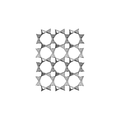Framework silicates
As framework silicates (tectosilicates) is referred to silicates , the silicate anions from a framework of corner-sharing SiO 4 - and AlO 4 - tetrahedron consist.
This division of silicates includes the feldspars and feldspar representatives (e.g. nepheline , leucite ), the most common minerals in the earth's crust. The technically important and naturally widespread minerals of the zeolite group are, with a few exceptions, also structural silicates.
The silicate frameworks enclose larger cavities in which large cations such as Na + , K + , Cs 2+ , Ca 2+ , Ba 2+ , Sr 2+ or molecules such as [NH 4 ] + , water or other complex anions such as SO 4 place Find. Due to their mostly loose structure, the tectosilicates are characterized by low density, light refraction and medium hardness (4–6).
Many of the aluminosilicate frameworks are traversed by wide, open channels (zeolites), which z. B. can absorb and release water or cations without the silicate framework becoming unstable. The technical application of these minerals as ion exchangers or molecular sieves is based on this.
classification
To Liebau
Liebau's classification treats the framework silicates as a link between silicate chains to form frameworks that are unlimited in three dimensions and subdivide the framework silicates based on the periodicity and branching of the silicate chains that build up the layers.
Periodicity:
It indicates after how many silicate chain links (SiO 4 - tetrahedron) the structure of a chain repeats itself.
Branch:
It indicates whether further SiO 4 tetrahedra branch off from a silicate chain . A distinction is made between openly branched silicate chains and cyclically branched silicate chains, in which the SiO 4 tetrahedra branching off the chain form closed rings.
According to Strunz
- Silicate framework of nepheline
- Silicate framework of the orthoclase
As with the layered silicates , the Strunzian classification of the structural silicates does not adopt the Libau nomenclature and criteria. The Strunz system divides the tectosilicates based on the incorporation of zeolitic water into the structure in the departments "tectosilicates (tectosilicates) without zeolitic H 2 O" (9F) and "tectosilicates (tectosilicates) with zeolitic H 2 O" (9G). The further classification is based on the size and connection of the silicate rings that make up the silicate frameworks and the occurrence of other anions.
9.F Tectosilicates without zeolite H 2 O
9.FA tectosilicates without further anions
- 9.FA.05 Nepheline group
- 9.FA.10 Malinkoite group
- 9.FA.15 Virgilit Group
- 9.FA.25 Lisitsynite group
- 9.FA.30 Feldspar : Alkali
- 9.FA.35 Feldspar : plagioclase
- 9.FA.40 Paracelsian Group
- 9.FA.45 Svyatoslavit group
- 9.FA.50 Slawsonit
- 9.FA.55 Lisetit group
- 9.FA.60 Stronalsite Group
- 9.FA.65 Danburit Group
- 9.FA.70 Lingunit
- 9.FA.75 Kumdykolite
9.FB tectosilicates with other anions
- Silicate framework of cancrinite
- 9.FB.05 Cancrinite group
- 9.FB.10 Sodalite group
- 9.FB.15
9.G tectosilicates with zeolitic H 2 O; Zeolite family
- Silicate framework of the natrolite
9.GA zeolites with four-ring chains connected via a fifth Si
- 9.GA.05 Natrolith Group
- 9.GA.10 Thomsonite group
- 9.GA.15 Edingtonite group
9.GB chains of simply connected rings of four
- Silicate framework of the analcime
- 9.GB.05 analcime group
- 9.GB.10 Laumontite Group
- 9.GB.15 Yugawaralith group
- 9.GB.20 Roggianite group
- 9.GB.25 Goosecreekite group
- 9.GB.30 Montesommait Group
- 9.GB.35 Parthéit Group
9.GC chains of double-linked quad rings
- Silicate framework of phillipsite (9.GC.10)
- 9.GC.05 Gismondin Group
- 9.GC.10
- 9.GC.15 Merlinoite Group
- 9.GC.20
- 9.GC.25 pearlialite group
- 9.GC.30 Boggsite Group
- 9.GC.35
9.GD chains of five rings
- Sililkat framework of the Levyn
- 9.GD.05 Gmelinit group
- 9.GD.10
- 9.GD.15 Levyn group
- 9.GD.20
- 9.GD.25 Offretit group
- 9.GD.30 Faujasite group
- 9.GD.35 mordenite group
- 9.GD.40 Dachiardite group
- 9.GD.45 Epistilbit group
- 9.GD.50 ferrierite group
- 9.GD.55 Bikitait group
9.GE panels with 4-4-1-1 structural units
- Silicate framework of Heulandite
- 9.GE.05 Heulandite group
- 9.GE.10 Stilbit group
- 9.GE.15 Stellerite Group
- 9.GE.20 Brewsterite group
9. GF leucite-type frameworks
- Silicate framework of Gottardiit
- 9.GF.05 Terranovaite group
- 9.GF.10 Gottardiit group
- 9.GF.15 Lovdarit Group
- 9.GF.20 Gaultit group
- 9.GF.30 Tschernichit group
- 9.GF.35 mutinaite group
- 9. GF.40 Tschörtnerit group
- 9.GF.50 Thornasite group
- 9.GF.55 direnzoite group
9.GG cages and double cages with 4, 6 and 8 rings
- 9.GG.05 Cowlesit group
9.GH. Unclassified zeolites
literature
- F. Liebau (1982): Classification of Silicates in: Reviews in Mineralogy Volume 5: Orthosilicates; Mineralogical Society of America
Web links
- webmineral: Nickel-Strunz Silicates Classification (Version 10)
- Mineralienatlas : Mineral class 9.F according to Strunz 9th edition - tectosilicates without zeolitic H 2 O
- mindat.org: Nickel-Strunz Classification - Tektosilicates without zeolitic H 2 O 10th edition
- University of Tübingen: Systematics of the minerals
Individual evidence
- ↑ a b c d Liebau 1982
- ↑ a b c d Mineral class 9.F according to Strunz 9th edition
- ↑ a b c d e f g h i j k Nickel-Strunz Silicates Classification (Version 10)
- ↑ a b c d e f g h i j k l Nickel-Strunz Classification - Tektosilicates 10th edition
- ↑ University of Tübingen: Systematics of Minerals - Tectosilicates (tectosilicates)






























